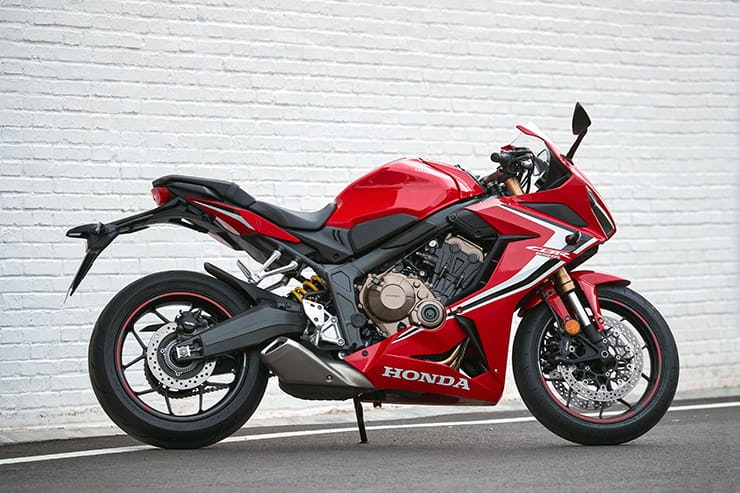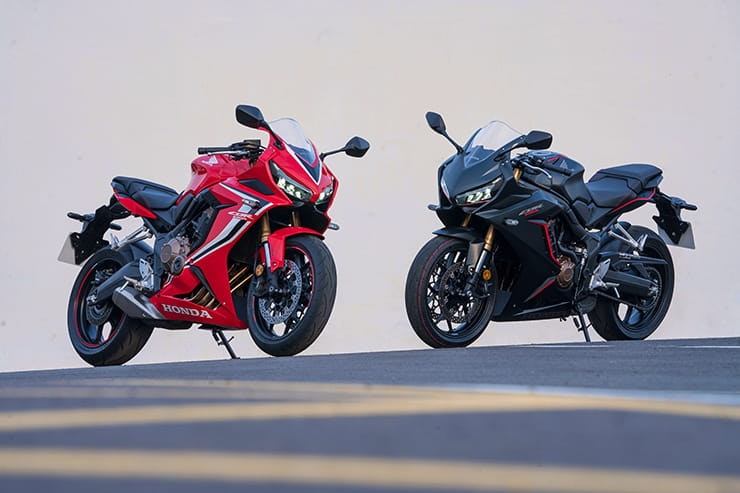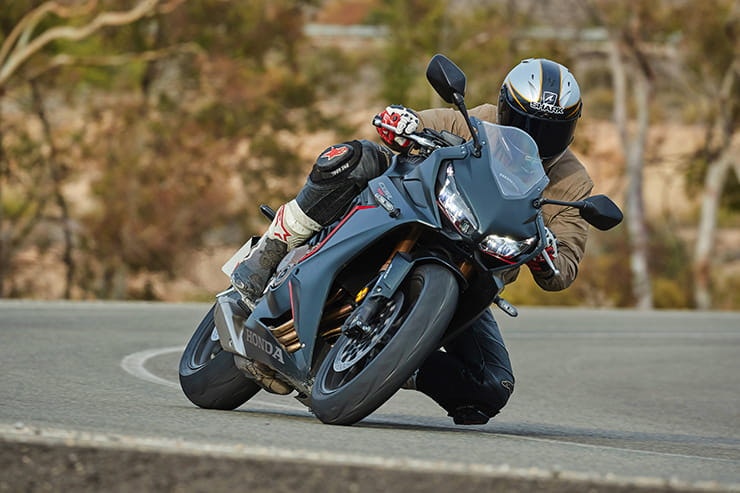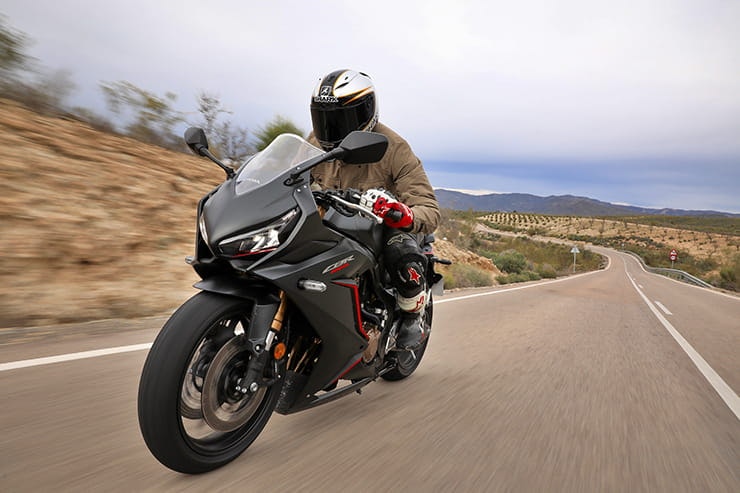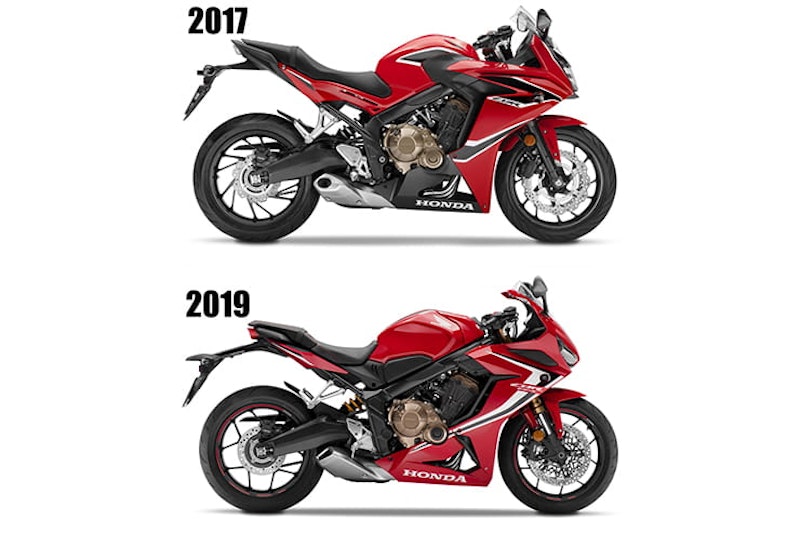Honda CBR650R (2019) - Review
BikeSocial Road Tester
28.01.2019
The bike in front, hunting down the next Andalucían apex mere milliseconds after successfully executing the previous one in a glorious swooping arc, looks uncannily like a Honda Fireblade. And its rider, cracking on at a properly rapid pace but with an imperious swagger that suggests his skills are barely off tick-over, bears more than a passing resemblance to BSB and TT legend Steve Plater.
That’ll be because it actually is Steve Plater riding a Fireblade.
Whose idea was it to make that pair the lead combo on a humble CBR650R launch in Spain? That’s like choosing an eagle to lead a pack of lemmings along a cliff edge.
Turns out it’s an inspired choice – because keeping up with a TT-winning ex-Superbike star on a litre sportsbike doesn’t half make the new CB650R look good (even if said racer isn’t so much as just getting out of first gear). And, sure enough, a flowing, high speed sweep through the chilly mountains around Almeria in southern Spain chasing a not-long retired international race winner on a 190bhp sportsbike does indeed bathe the smaller CBR in the golden light of some serious reflected glory. Just as Honda intended.
It also shows, faithfully, just how far the new CBR650R has come from its debut in 2014 as a no-frills, budget middleweight. That bike, the CBR650F (and a tweaked updated version in 2017), was a high-revving inline four-cylinder all-rounder that had bags of sporting potential compromised by a relaxed riding position and too many cost corners cut in terms of equipment and spec level – right way up forks, two-pot sliding caliper brakes, feature-lite dash, no rider aids. It was a nice bike, better than it should’ve been but not as good as it could’ve.
The CBR650F was assembled in Thailand and slotted into the busy budget A2-licence compliant market (meaning it couldn’t make more than 94bhp and still be allowed to be restricted to 47bhp for A2 licence holders). The class was stuffed with even cheaper rivals – most of which were slightly hum-drum parallel twins. It was a right old battle of the bargains.
But now the new, aggressively styled, tuned, revamped and upgraded CBR650R – the F has F’ed-off – might be about to change all that.
engine layout – one of the last of inline four middleweights, and it’s good to make them howl
riding position – neither comfort nor control is compromised by being marginally more sporty
handling – agility, ride quality and chassis balance; what quality budget suspension should feel like
dim dash – brighter, please – or invert it
shrinking tank – 120 miles isn’t the worst, but bigger is better
duff Dunlops – the CBR650R deserves better rubber
Honda CBR650R Review | The middleweight sports Honda is back
BikeSocial sent roving road tester, Simon Hargreaves, to Spain for the international riding launch of the 2019 Honda CBR650R and CB650R and here's his introduction to the bike and first impressions...
Honda CBR650R prices, PCP deals, and availability
In dealers from February - OTR: £7729.00
Colours: Matt Gunpowder Black Metallic or Grand Prix Red
Honda PCP deal
2019 Honda CBR650R - Accessory packs
Sports pack: seat cowl,tank pad, double bubble screen, quickshifter – £520.00
Comfort pack: heated grips plus fitting kit, double bubble screen, 12v socket – £355.00
2019 Honda CBR650R - Power and Torque (claimed)
93.9bhp @ 12,000rpm
47.2 lb.ft @ 8000rpm
The CBR’s 649cc inline four motor is essentially a tuned and refined CBR650F unit. Claimed power is up by 4.1bhp and 1000rpm, from 89.8bhp @ 11,000rpm to 93.9bhp @ 12,000rpm. Peak torque remains the same 47.2 ft.lb as before, but now up from 8000rpm to 8500rpm.
2019 Honda CBR650R - Engine, gearbox and exhaust
One thing most mid-capacity inline fours like to do is rev. Lots and lots of lovely revs. Well, you say ‘most’ – the CBR650R, and its sibling CB650R streetbike, are in the minority. The only other inline four middleweights are Yamaha’s R6 and Kawasaki’s ZX-6R, both of which live at the extreme end of the sportsbike spectrum in terms of philosophy, performance and price. Everything else in the 600cc range, and at the A2-friendly CBR’s price point, is a parallel twin, V-twin or even, perish the thought, a single-cylinder (but that’s just weird). So it’s left to the CBR to fly the flag for a 12,500rpm redline.
At mid-speed the CBR glides along at mid-revs, motor spinning smoothly at 6000rpm in top at 80mph – but that’s only halfway to the danger zone. There’s another 6000rpm to go; more, if you want hit the limiter – which isn’t easy to do by accident, unlike your average parallel twin that seems to stop dead just when you’re enjoying yourself.
All those revs makes the CBR’s motor very, very flexible. It lacks a twin’s low-down huff and puff, but instead the CBR draws up its power in a long, linear drive, fuelling flawlessly from 2000rpm and gathering surprising pace as the needle escalates skywards beyond 4000rpm, then fizzing above 6000 and making a whole lot of noise past 8000rpm. But it’s not frantic and the power delivery is never tiring; it’s just thrillingly elasticated, like a pair of sexy knickers (or pants; the CBR’s powerband is gender neutral), and feels considerably faster than it probably is. It reminds me of sports 600s in the 1990s, when the only middleweights worth a sniff were inline fours, and tear-arsing about like lunatics was – you know – fun, anti-social, and everyone did it.
Honda say the changes to the CBR’s motor for 2019 aren’t just about producing a bit more peak power, they’re also about smoothing, refining and augmenting throttle response low down – without a direct comparison it’s hard to judge, but there’s a lot more acceleration from mid-revs than feels appropriate for a 650. It feels fit. And sporty. And so, so thrashable.
There’s nothing exceptional going on inside the new CBR650R’s motor – it’s still a conventional, compact, liquid cooled 180° crank inline four with double overhead cams, bucket and shim valvetrain, four valves per cylinder, and block canted forward at 30°. Friction is minimised by asymmetric short-skirt pistons for reduced bore contact, and pumping losses are reduced with crankcase ventilation between journals. A standard, stacked, six-speed transmission – with ratios as per the previous model – delivers drive to the back wheel.
Higher revs for the same quantity of torque means increased peak power. And so the new CBR’s 4.1bhp power hike over the previous 650F has been achieved by letting the motor rev harder, with a tweak to cam timing (presumably more valve overlap), an ECU remap, revised piston crown shape for a slightly higher compression ratio, and reshaped and redesigned intake and exhaust plumbing.
In particular, the CBR’s airbox is now fed by higher capacity twin air ducts instead of the previous models’ single intake – cheekily, Honda say the CBR is subject to a ram-air effect that boosts airbox pressure by up to four times compared to the previous CBR at ‘high speed’. Honda claim this adds 5% more power over its 93.9bhp peak.
Which sounds great! But hang on, say readers who are paying attention – wake up at the back! – Honda’s claimed 93.9bhp peak power figure is from a static dyno; 5% extra is 4.7bhp... so Honda are saying the CBR actually develops 98.7bhp at high speed.
Sounds great, but the reason the CBR makes 93.9bhp (and not 115bhp, which the design is perfectly capable of if Honda wished) is because it’s 0.1bhp away from the 94bhp maximum limit for a bike to remain A2 licence compliant – and so which therefore means the CBR can be restricted down to 47bhp. If it actually makes more power than it should... does anyone know how ‘legal’ a ram-air effect is in terms of A2 licence compliance? But we like the idea of Honda being a bit naughty.
To get the CBR down to an A2-friendly 47bhp, Honda use an alternative pair of plastic intake ducts with bores partially blocked by a plastic blanking plate to choke the motor, and an appropriate ECU remap. De-restricting it should take around an hour, say Honda technicians, but only by a dealer. Stanley knives are not involved.
This also means the CBR650R is unlikely to get much more powerful in the near future, unless Honda build a separate 94bhp model, as per A2-compliant versions of Kawasaki’s Z900 and KTM’s 790 Duke, say – and then build an RR-spec version for nutters. I like the sounds of that. In the meantime, it also explains why the CBR650R doesn’t already make more power as the old CBR600F of the 1990s (in fact, by adding a decent chunk of zip and throttle response to the CBR’s engine, Honda have basically re-created pretty much the same motor, in terms of power and revs, that powered the 1995 CBR600F-S. Gnarly old timers should weep for joy).
Other engine changes to the new CBR650R motor over the F model include the addition of a slipper clutch with a lighter lever action than previously (Honda say it’s 12% lighter; it’s noticeable in town), and the underslung exhaust has been tilted upwards, angled towards the rider’s delicate ear drums. The effect, combined with the new twin air intakes, is a deeper, more beefy riding soundtrack at medium revs, and more of a shriek when you’re caning it. Have we mentioned? The motor likes to be caned.
Back on the road, I’m pretty sure Steve Plater has disconnected his Fireblade’s brake light. We’re bopping along holding a steady 70-80mph through the corners at knee-down angles, and I’ve not seen it flicker once. But anyway, the CBR650R so deep in its element it’s practically submersed in Zen-state adrenaline – mid-90s horsepower is ideal for maintaining and enjoying a rapid real world pace. It’s neither intimidatingly fast and ultimately reined-in, like Steve and his litre sportsbike, nor furiously demented, like a nailed-on supersports 600. It’s the Goldilocks zone of performance.
2019 Honda CBR650R - Economy
The CBR’s new engine performance has a minor reciprocal effect on fuel consumption: Honda’s figures say it uses slightly more fuel than the pervious bike. The new motor is claimed to drink at 57.6mpg compared to the previous engine’s 59.3mpg, which is barely noticeable.
But the new tank size is: it’s nearly two litres smaller, at 15.4 litres down from 17.3 litres – I ask a Honda engineer why: he explains it’s because the new dash meant moving the ignition barrel from in front of the yoke, to behind it, eating into the tank area. That’s packaging for you. A bit of BikeSocial maths shows that’s around 30 miles less tank range on the new bike, down from a theoretical 220 miles to 195 miles. That’s never a good thing, regardless of where the key goes.
On Spanish roads being fairly silly, the CBR’s actual fuel consumption averages around 45mpg, which would give a tank range of around 150 miles to empty – so finding a filling station every 120 miles or so.
2019 Honda CBR650R - Suspension, chassis and weight
The CBR’s frame is broadly the same pressed steel twin spar as the previous CBR650F. Swingarm pivot plates are now also pressed sections instead of cast – this saves 1.9kg in weight. The engine’s rear mounting points have moved from attaching to each side plate, to now using a single, central cross-spar – it sounds like a minor detail, but when I ask Honda why the new engine feels so much smoother than the harsh buzz of the previous motor, they point to the new engine-frame bracket. Neat – that’s why they get paid the big bucks.
The subframe is also new – still welded to the main frame, but now angled slightly upwards and 60mm shorter for a more compact back end.
Suspension is new – forks are still 41mm Showas and still non-adjustable, but are now upside down have a new acronym: now SFF (Separate Function Fork) instead of the previous SDBV (Showa Dual Bending Valve). SFF forks have the damping operation in one leg and the springing in the other, reducing weight, friction and, presumably, cost, and are claimed to improve ride quality. Which, as I recall, is what Showa claimed when they introduced the SDBV forks two years ago on the CBR650F.
At the back, the cantilever Showa shock gets the addition of a rubber bump stop, which Honda call a ‘pillow ball’ and is a fairly crude form of extra damping cushion when the shock goes to full compression. They use the same idea on the new Gold Wing, so at least the CBR is in good company. The shock has ten-way preload adjustment but, as per the previous model, no damping adjustment. Rake, trail and wheelbase are all as before.
However, Honda say the CBR is 6kg lighter than its F-ing predecessor, at 207kg v the CBR650F’s 213kg. The weight saving comes partly from the frame (1.9kg lighter), partly from details like the shorter subframe and changes to wheels, suspension and component details – but also from the smaller tank (less fuel) and – surprisingly – less oil. The new engine carries 2.7 litres of oil; the old motor held 3.5 litres. Confused, I ask Honda’s technicians if the sump is smaller, but no – it turns out they simply put less in there, and the engine is still safe. I ask, half joking, if that means the dipstick is longer. Yes, it is. Well, it should make servicing the old bikes cheaper if you know they can run safely on 800ml less oil. Overall, reducing the CBR650R’s fluid levels saves 2.1kg – and that really is next level weight saving.
Brakes, wheels and tyres
The CBR’s move to upside down forks permits an obvious transition to radial calipers, and four-pot radial Nissins instead of the conventionally mounted previous four-pots. Non-wavy front disc sizes drop 10mm to 310mm. Cast aluminium wheels are new slim-spoke design, tyre sizes stay the same 120/70 and 180/55, with Thai-made Dunlop D214 Sportmaxes.
2019 Honda CBR650R - Ergonomics and comfort
The CBR gets significantly revised, sportier riding position than the old CBR650F. Clip-ons are now mounted below the top yoke, with the bars themselves roughly at the level of the yoke. They’re 30mm lower and 30mm further forward than the CBR650F, which had a distinctly sports touring stance. New, lightweight footpegs are 3mm further back and 6mm higher than before, but the 810mm seat is the same as the F-model.
The result isn’t as dramatic as it sounds. The CBR is still no head-down, arse-up race replica; the riding position is more forward-leaning than before, but it still falls a long way short of a pure sportsbike, such as the Fireblade – it’s a comfy, all-day stance, with not even a hint of wrist-ache over five hours (not that there was much time to sit still, ahem). You could still easily contemplate three or four touring days in the saddle, and Honda clearly haven’t forgotten how to make the sporty all-round riding position that graced the mid-90s CBR600F.
2019 Honda CBR650R - Handling
It might be basic, it might be cheap, it might be non-adjustable, but the CBR’s Showa suspension is very, very good. The CBR isn’t quite as agile as its naked CB650 sibling (that sounds wrong); the streetbike’s longer, flat bars and upright riding position gives greater leverage and less weight over the front end, so it flicks into the apex while the CBR carves into it. But the CBR is hardly sluggish at changing direction; it’s just more deliberate.
Ride quality is exceptional – Honda have long managed to tease above-average suspension control from apparently budget, non-adjustable suspension, and the CBR is a perfect example. With the rider’s weight more heavily biased over the front end than previously, uses up more of its travel under normal riding and feels slightly less plush than the more upright, CB650R. But it gives no cause for concern, bundling along the Almerian asphalt at the aforementioned brisk pace and soaking up bumps as well as my hefty old post-Xmas weight transfer on the brakes or on the gas.
The CBR650R feels less secure on its Dunlop D214s than the CB does on its supposedly touring Metzelers. They have a solid, remote feel, and don’t generate a great deal of heat even after some hectic cornering. The idea of putting the CBR on something much stickier is an enticing prospect (a few years ago I hammered the original 2014 CBR650F on an Avon Spirit ST tyre launch at Portimao, and it was a lot more fun than it should have been).
Equipment
Hooray – instead of the old F-model’s cheap, monochrome display is no more, and instead the CBR gets a widescreen dash with gear position indicator, fuel gauge, tacho and mpg readouts. At night it lights up like a city skyline, but in broad daylight, behind a tinted visor, it’s really, really dim. Brightness is adjustable – but even on max it’s out-glared by a cloudy sky. That’s a bit of a pain. You can’t adjust the brightness, but as it’s already on max I don’t want to actually make it less visible, thanks. Being able to invert the display would help. But you can’t.
But in another hooray, the CBR also gets Honda’s rudimentary traction control. You could argue, probably correctly, a 94bhp 650 doesn’t need it – but it’s nice to have, just in case and especially on those blummin’ Dunlops. It’s also nice to be able to switch the TC off while riding, using the headlamp flasher switch on the left handlebar, for moments when you feel the need to wheelie. Naughty Mr Honda again. We like it.
Not quite so keen on the new emergency brake lights, that flash the indicators and brake lights front and rear under hard braking (but before the ABS cuts in). It might be a life-saver on the road, but if you’re on a track day and up a CBR650R rider’s chuff and he bangs them on unexpectedly, it won’t half make you jump.
2019 Honda CBR650R - Verdict
Honda say the aim of the CBR’s revamp is to focus its appeal towards younger riders – they say 55% of buyers of the previous CBR650F were under 40 years old, and nearly a third were between 21-30. So that’s the reasoning behind what is an aggressive, even sportier restyle.
For old giffers such as I, riding the CBR650R has a strong whiff of déjà vu. I’m sure I’ve ridden a bike like this before. A middleweight inline four Honda sportsbike with a steel frame, making over 90bhp and weighing around 210kg? Sounds familiar. A practical-but-sporty riding position, and the feeling you could ride 500 miles in one hit in comfort one day, then do a track day the next and be happy with both? Feels familiar. Balanced, neutral steering and a wide, flat spread of torque? Definitely been here before.
And I have, in 1995, on a CBR600F-S. There are lots of similarities – but lots of differences too. The reality is the new bike has more features, better suspension, less weight and sharper handling. It’s also getting on for half the price. In 1995, a CBR600 cost £6525 – which is £12,322 in today’s money. The CBR650R is £7729. That has to be good value.
Against its rivals, it’s harder to place the new CBR. The F models clearly sat at the top end of a slew of Japanese A2-compatible middleweights, such as Kawasaki’s Ninja 650 (£6499), or Yamaha’s MT-07 (£7299). Its inline four motor was a point of difference; I preferred its high-revving character, and the fact when you wound it up it felt more like a smaller version of something bigger and faster, rather than a slightly wheezy, occasionally anaemic, throbbing twin.
But the new CBR’s price is edging it closer towards a different realm of performance, and starting to nudge into the territory of the last remaining proper sports 600 under ten grand – Kawasaki’s ZX-6R. The 6R would slay the CBR on just about all counts bar comfort. But at least it shows how good Honda’s CB650R and CBR650R can be mentioned in the same breath. And hey, it just about keeps up with a snoozing Steve Plater on Fireblade.
The middleweight sports Honda is well and truly back.
2019 Honda CBR650R - Technical Specification
Looking to insure this bike? Find out about Bennetts motorbike insurance.
